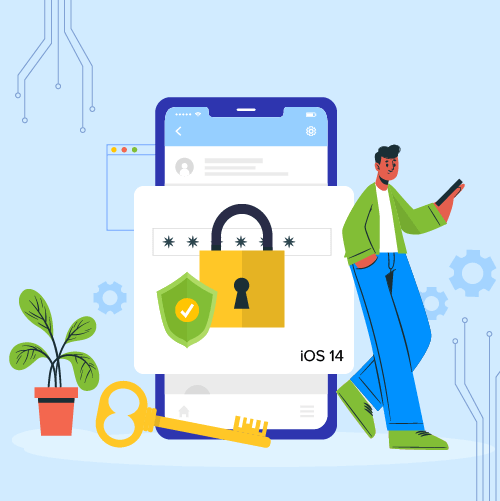- The List of Privacy-Centric iOS 14 Updates
- 1. Changes in IDFA and store-level control
- 2. Changes in app install attribution
- 3. Control over geo-location access
- 4. Privacy report highlighting ‘tracking’ companies
- How is Appinventiv Preparing for the Changed iOS 14 App Development Process?
- 1. Use SKAdNetwork for advertisement attribution
- 2. Non-individually identifiable IP address-based tracking
Apple has a habit of introducing revolutionary changes year after year with every new operating system launch. 2020 was no different. In fact, in many ways, it was the most revolutionary year for Apple in terms of advancing user experience and privacy.
In case you missed out on the features that the new iOS 14 updates comes with, head on to our article – How to prepare your app for iOS 14.
However, we can presume that by this time you must have gotten acquainted with the key aspects of iOS 14 privacy features. But do you know that the update will carry an impact on the process of how your partnered iPhone app development company handles your app development and distribution?
Let us talk about it in detail in this article today.
The List of Privacy-Centric iOS 14 Updates
The biggest announcement that Apple has made in terms of the iOS update that will be made next year is giving users the option to clock IDFA identifier at the application level. A move that strengthens the tech giant’s position in the Apple vs Android, which platform is more secure debate, would require the apps to ask the users for permissions to gather and share users’ data.
There are other privacy-related moves as well, but let us attend to IDFA first.
1. Changes in IDFA and store-level control
What is IDFA?
Identifier for Advertisers is a unique identifier for all mobile devices which is used for targeting and measuring the effectiveness of the advertisements on a user level across all the mobile devices.

What is the update about?
For every app install, users will have to opt in to IDFA. When developing apps for iOS 14, app publishers will have to provide a summary of privacy practices on the basis of which users will decide whether they want to opt-in IDFA or not.
The impact of this update lies in ad campaign becoming incapable of performing control recency, optimizing and measuring ad performance, or perform behavior-based segmentation. Additionally, the move is contributory to consent fatigue, which would increase the instances of users declining the data view request.
The impact of the update on the advertisers will be two-fold –
- Retargeting to users will not work in the iOS application development process if the users opt-out of sharing their IDFA. Brands that don’t use deterministic variables like a phone number or email id (like Google and Facebook do) will witness a reduction in the targetable audiences.
- Because of the limited access to IDFA, brands will not be able to show relevant ads to the users, a move that might direly impact user experience and ad monetization efforts of iOS app development.
2. Changes in app install attribution
iOS 14 comes with an updated SKAdNetwork interface that offers a method for Apple to notify the ‘ad network’ when a campaign creates app install conversion.
The impact of this update is the negligence of another type of app conversions for which a mobile app campaign would want to optimize other than app installs.
3. Control over geo-location access

Presently, iOS users have control over which apps access their location through the ‘Location Service’ setting. The new update will allow the users to opt-out of precise location sharing. And when that happens, only approximate geolocation data will be shared with the apps.
4. Privacy report highlighting ‘tracking’ companies
Apple presently comes with the feature of Intelligent Tracking prevention or ITP which blocks cross-domain tracking. With iOS 14, there will now be a ‘Privacy Report’ passed to the users in addition to the ITP. It will tell the users which companies it is blockchain from viewing their data.
The impact of this update is more image-based than anything else. Brands have multiple use cases for tracking users – recency control, frequency capping, behavioral-based targeting, spend attribution, etc. But the update will give the users a perception that every company has the same tracking intent.
How is Appinventiv Preparing for the Changed iOS 14 App Development Process?
iPhone app development has always been one of our strongest suits. We have always one of the first iOS app development company to run hypothesis testing on all the new updates. iOS 14 version is no different.
Our team of iOS app developers has deep-dived into how iOS 14 impacts app creation and promotion and while we have looked into the changes that we will have to make the app ready for iOS 14.
The primary step for us was to peruse the platform-wise recommendations for the iOS 14 update.
The documentations helped us get on top of the changes that were coming with iOS 14 and what we needed to do to prepare for them. Keeping technicalities aside, let us share our plans in terms of making your app pass Apple’s updated security principles in layman’s terms. But first thing first, let us look into the ways the app ecosystem is going to change in 2021.
The way iOS 14 influence app development will see the following things happening –
- The space between organic and paid revenue and installs will get blurry
- The efficiency of user acquisition and ad monetization will lower
- The user-level ad reporting will become functionally impossible with iOS 14
- Another impact of iOS 14 will be that retargeting campaigns will not be viable anymore
- Apple’s SKAdNetwork is poised to become the source of ad attribution on iOS
- Post-install events will majorly be attributable for around 24 hours
In light of these changes, the first thing that we will be focusing on is ensuring that the SDKs we use across our iPhone app development services are up to date. Virtually every SDK – analytics, attribution, and ad monetization, etc. will have to be updated for accommodating iOS14.
Secondly, we will shift our focus on top-of-funnel activities – like ad watch, tutorial completion, etc. – instead of button funnel-like subscriptions and purchases.
Lastly, we will be revisiting how we ask for consent from the users. After ensuring that the users are having a good experience within the app, we will plan strategically-timed push notifications explaining how the tracking will elevate their experience in the application. Here’s a snapshot of what that would look like –

Other than these, going by the statistics that over 30% of the iOS users have already disabled IDFA sharing, we will be exploring new approaches to help our clients retain their growth marketing expectations without relying on personal information. Here are some of them –
1. Use SKAdNetwork for advertisement attribution

Apple has released SKAd Network that enables Apple to manage the attribution passed to the Registered Ad network. While there are ways to optimize and scale marketing with SKAdNetwork, like how it helps identify redownloads and track attribution, they are not very ideal because of multiple reasons –
- Allows only click-based attribution
- No date stamp parameter is provided
- The campaign IDs are limited to 100 per ad network.
2. Non-individually identifiable IP address-based tracking
Another way brands can negate the iOS 14 impact on app distribution is by relying on the users’ truncated IP addressed for advanced contextual targeting and attribution. This way, they won’t have to identify any individual user.
If you are looking for an iOS application development company that is skilled to help migrate your existing application to iOS 14 while having a complete understanding and solutions to how iOS 14 impacts app creation, reach out to our team.


- In just 2 mins you will get a response
- Your idea is 100% protected by our Non Disclosure Agreement.

Apple Vision Pro App Development - Benefits and Use Cases for Businesses
While we dive into a future where reality is reimagined, it's crucial for businesses to understand that the launch of Apple Vision Pro represents not merely an innovation but a revolution. It can help them elevate the perception of the world, offering unprecedented opportunities for interaction, creativity, and productivity across industries. Developing apps for Apple…

Which Language Is Best For iOS App Development?
If I shouted “iOS or Android” in the middle of a crowd, the following two things may happen: A huge crowd may cheer for Android, thinking what is the fuss about iOS? The people cheering for iOS not caring about another OS This is not to say that iOS is better (let’s not start a…

How to Prepare Your App for iOS 14 Update
Set to release in the fall of 2020, iOS 14 was announced in the June of 2020 with a slew of changes and a series of groundbreaking announcements. Like clockwork, Apple comes with a multitude of industry transforming OS additions devised to make app experiences immersive, secure, and easy. But this time around, Apple has…















